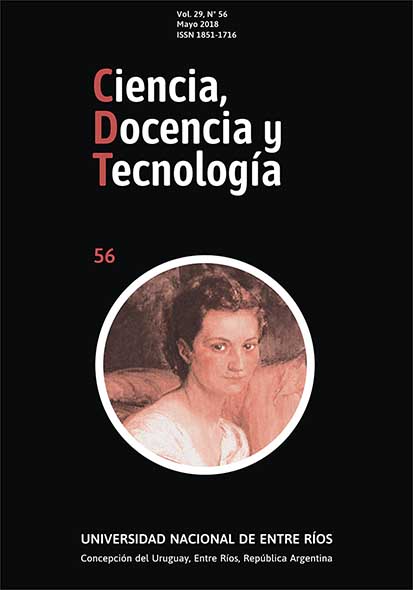Science Teachers and the Program “Conectar Igualdad” in the City of Córdoba (Argentina)
DOI:
https://doi.org/10.33255/2956/337Keywords:
Model 1, 1, Connecting Equality Program, Teaching Practices, Science EducationAbstract
In the framework of the program “Conectar Igualdad” (Connecting Equality Program) we proposed to inquire about the way in which science teachers use ICT in their everyday life; about their perceptions related to the presence of netbooks in the classrooms; about the way they use netbooks in their educational practices and about their expectations. For these purposes, we implemented different research strategies which included two types of questionnaires and interviews to be answered by secondary school teachers in the city of Cordoba (Argentina).Based on the results obtained, we found that teachers integrate ICT in their everyday lives. They stated that the presence of these technologies in the classroom generates problematic situations but they also identify them as positive tools which create new opportunities. Even though most teachers integrate technologies in their practices poorly, we detected practices oriented to a deeper integration that would allow "thinking-with" technology.
Downloads
References
AGUIAR, D.; CAPUANO, A.M.; DIEZ, M.A.; FOURÉS, C.; SILIN, I. (2016). Cambios y permanencias en las prácticas de enseñanza con TIC, Neuquén, Argentina, en: Ciencia, Docencia y Tecnología, 27(53):315-341.
ALVAREZ-QUIROZ, G.B.; BLANQUICETT ROMERO, J.C. (2015). Percepciones de los docentes rurales sobre las TIC en sus prácticas pedagógicas, en: Ciencia, Docencia y Tecnología, 26(51):371-394.
ARANCIBIA HERRERA, M.M.; CASANOVA SEGUEL, R.; SOTO CARO, C.P. (2016). Concepciones de profesores sobre aprender y enseñar usando tecnologías, en: Ciencia, Docencia y Tecnología, 27(52):106-126.
AREA, M. (2008). Innovación pedagógica con TIC y el desarrollo de las competencias informacionales y digitales, en: Investigación en la escuela, 64:5-18.
AREA, M.; SANABRIA, A. (2014). Opiniones, expectativas y valoraciones del profesorado participante en el Programa Escuela 2.0 en España, en: Educar, 50(1):15-39.
AREA, M. (2010). «El modelo 1x1 (una computadora por alumno) en Iberoamérica: Opiniones, entrevistas, videos y otras webs». Organización de Estados Iberoamericanos (OEI). Disponible en: <http://www.oei.es/historico/noticias/spip.php?article7665=> [5 de abril de 2017].
AREA, M.; HERNÁNDEZ, V.; SOSA, J.J. (2016). Modelos de integración didáctica de las TIC en el aula, en: Comunicar, 47(24):79-87.
BALANSKAT, A., BLAMIRE, R.; KEFALA, S. (2006). The ICT Impact Report. A review of studies of ICT impact on schools in Europe. European Schoolnet, European Comission. Disponible en: <http://colccti.colfinder.org/sites/default/files/ict_impact_report_0.pdf> [6 de julio de 2016].
BENAVIDES, F.; PEDRÓ, F. (2007). Políticas educativas sobre nuevas tecnologías en los países iberoamericanos, en: Revista Iberoamericana de Educación, 45:19-69.
BORBA, M.; VILLARREAL, M. (2005). Humans-with-media and the Reorganization of Mathematical Thinking: information and communication technologies, modeling, experimentation and visualization. New York: Springer.
CANAVARRO BENITE, A.M.; MACHADO BENITE, C.R. (2008). O computador no ensino de química: Impressões versus Realidade. Em Foco as Escolas Públicas da Baixada Fluminense, en: Ensaio – Pesquisa Educação em Ciências, 10(2):303-319.
CASABLANCAS, S. (2014). La cuestión de la formación docente en los modelos 1 a 1. El caso del proyecto piloto Escuelas de innovación, dentro del programa «Conectar igualdad» (República Argentina), en: Educar, 50(1):103-120.
COLÁS BRAVO, M.P.; BUENDÍA EISMAN, L. (1994). Investigación Educativa. Sevilla: Ediciones Alfar.
COLL, C. (2008). Aprender y enseñar con las TIC. Expectativas, realidad y potencialidades, en: Boletín de la Institución Libre de Enseñanza, 72:17-40
COLL, C. (2009). Aprender y enseñar con las TIC: expectativas, realidad y potencialidades (pp.113-126). En: CARNEIRO, R. y ots. (Comp.). Los desafíos de las TIC para el cambio educativo. Colección Metas Educativas 2021. OEI. Fundación Santillana.
CONSEJO FEDERAL DE EDUCACIÓN. (2010) Anexo I de la Resolución 123: Las políticas de inclusión digital educativa. El Programa Conectar Igualdad. Disponible en: <http://www.me.gov.ar/consejo/resoluciones/res10/123-10_01.pdf> [5 de abril de 2017].
CUBAN, L.; KIRKPATRICK, H.; PECK, C. (2001). High Access and Low Use of Technologies in High School Classrooms: Explaining an Apparent Paradox, en: American Educational Research Journal, 38(4): 813-834.
DÍAZ-BARRIGA, F. (2010). Los profesores ante las innovaciones curriculares, en: Revista Iberoamericana de Educación Superior, 1(1):37-57.
ERTMER, P.A. (2005). Teacher Pedagogical Beliefs: The Final Frontier in Our Quest for Technology Integration?, en: Educational Technology Research and Development, 53(4):25-39.
FIORENTINI, D.; LORENZATO, S. (2010). Investigación en educación matemática. Recorridos históricos y metodológicos. Campinas, SP: Autores Associados.
FONTDEVILA, P.A. (2011). Estudio de caso: Conectar Igualdad, en: Revista Iberoamericana de Ciencia Tecnología y Sociedad, 6(18).
HIGGINS, T.E.; SPITUNIK, M.W. (2008). Supporting Teachers’ Use of Technology in Science Instruction through Professional Development: A Literature Review, en: Journal of Science Education and Technology, 17: 511‐521.
INAN, F.A., LOWTHER, D.L., ROSS, S.M.; STRAHL, J.D. (2010). Pattern of classroom activities during students’ use of computers: relations between instructional strategies and computer applications, en: Teaching and Teacher Education, 26(3):540–546.
INAN, F.A.; LOWTHER, D.L. (2010) Laptops in the K-12 classrooms: Exploring factors impacting instructional use, en: Computers & Education, 55(3):937-944
JUNG, I. (2005). ICT-Pedagogy Integration in Teacher Training: Application Cases Worldwide, en: Educational Technology & Society, 8(2): 94-101.
KOZMA, R.B. (2003). Technology and Classroom Practices, en: Journal of Research on Technology in Education, 36(1):1-14.
LAGO MARTÍNEZ, S. (2012). Inclusión digital en la educación pública argentina. El Programa Conectar Igualdad, en: Revista Educación y Pedagogía, 24(62): 205-218.
LAGOS CÉSPEDES, M.E.; SILVA QUIRÓZ, J. (2011).Estado de las experiencias 1 a 1 en Iberoamérica, en: Revista Iberoamericana de Educación, 56:75-94.
LINN, M.C. (2003). Technology and science education: starting points, research programs, and trends, en: International Journal of Science Education, 25(6):727-758.
LITWIN, E. (2005). Tecnologías educativas en tiempos de Internet. Buenos Aires: Amorrortu.
LUGO, M.T; KELLY, V. (2011). El modelo 1 a 1: un compromiso por la calidad y la igualdad educativas. La gestión de las TIC en la escuela secundaria: nuevos formatos institucionales. Serie gestión educativa en el modelo 1 a 1. Programa Conectar Igualdad. Buenos Aires: Ministerio de Educación de la Nación.
MANSO, M.; PÉREZ, P.; LIBEDINSKY, M.; LIGHT, D.; GARZÓN, M. (2011). Las TIC en las aulas. Experiencias latinoamericanas. Buenos Aires: Paidós.
MONEREO, C. (Comp.). (2005). Internet y competencias básicas. Barcelona: Grao.
MOUZA, C. (2008). Learning with Laptops: Implementation and Outcomes in an Urban, Under-Privileged School, en: Journal of Research on Technology in Education, 40(4):447-472.
MUELLER, J.; WOODA, E.; WILLOUGHBY, T.; ROSS, C.; SPECHT, J. (2008). Identifying discriminating variables between teachers who fully integrate computers and teachers with limited integration, en: Computers & Education 51:1523-1537.
OCCELLI, M. GARCIA, L.; MASULLO, M. (2012). Integración de las TICs en la formación inicial de docentes y en sus prácticas educativas, en: Revista Virtualidad, Educación y Ciencia, 3(5): 53-72.
PENUEL, W.R. (2006). Implementation and Effects Of One-to-One Computing Initiatives: A Research Synthesis, en: Journal of Research on Technology in Education, 38(3):329–348.
POMAR, S.; GONZÁLEZ, J.M.; IBÁÑEZ, F.; TELLO, N.; BIBER, P.; OCCELLI, M.; GARCIA ROMANO, L. (2016). PREGUNTIC: un juego digital para la enseñanza de las ciencias naturales en la escuela secundaria. En FERREYRA. H.A. (Ed.). El currículum de Ciencias Naturales de la Educación Secundaria: retos y desafíos de cara al futuro: dossier. Córdoba: EDUCC -. Disponible en: <http://pa.bibdigital.uccor.edu.ar/873/1/DOSSIER%20UNICEF.pdf > [5 de abril de 2017].
RELPE (2011). Experiencias 1 a 1 en América Latina. Red Latinoamericana de Portales Edcuativos. OEI. Disponible en: <http://www.relpe.org/wp-content/uploads/2013/04/07-Experiencias-1-a-1-en-Am%C3%A9rica-Latina.pdf> [10 de febrero de 2017].
RODRIGUES, S. (2004). Digital Divides: E-literacy in Science Classrooms when Using Information Communication Technologies, en: Science Education International, 16(4):303-323.
SALOMON, G. (2001). Cogniciones Distribuidas. Buenos Aires: Amorrortu Ed.
SANCHO, J.M. (1998). La tecnología: un modo de transformar el mundo cargado de ambivalencia. En: SANCHO, J.M. (Comp.). Para una tecnología educativa. Barcelona: Editorial Horsori.
ZANOTTI, A.; ARANA, A. (2015). Implementación del Programa Conectar Igualdad en el aglomerado Villa María-Villa Nueva, Córdoba, Argentina, en: Ciencia, Docencia y Tecnología, 26(50):120-143.
ZUCKER, A.A.; LIGHT, D. (2009). Laptop Programs for Students, en: Science, 323: 82-85.
Downloads
Published
How to Cite
Issue
Section
License
Copyright (c) 2018 Maricel Occelli, Leticia Garcia Romano

This work is licensed under a Creative Commons Attribution-NonCommercial-ShareAlike 4.0 International License.
The authors retain the copyright and grant the journal the right to be the first publication of the work, as well as licensing it under a Creative Commons Attribution License that allows others to share the work with an acknowledgment of the authorship of the work and publication initial in this magazine. All content is published under the Creative Commons 4.0 international license: Attribution-Non-Commercial-Share Alike.






